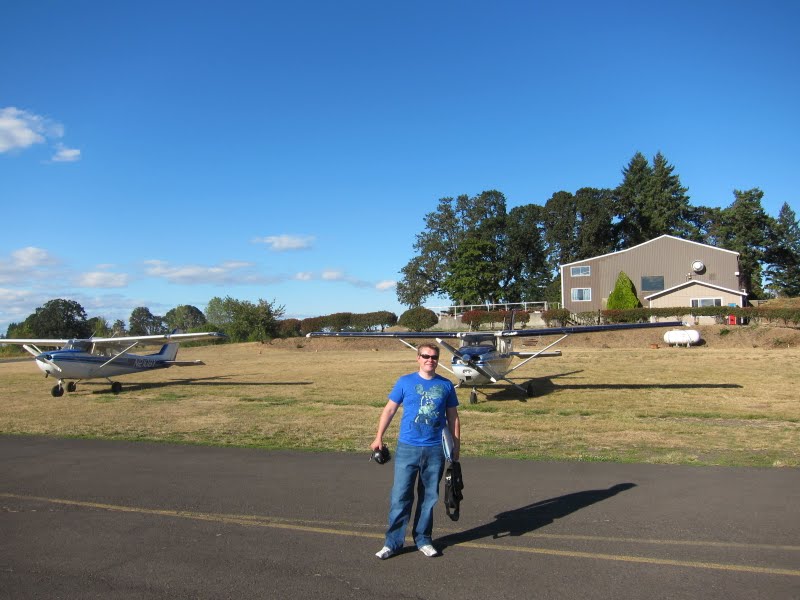-
Fill ‘er Up

 Yesterday afternoon I got to fly again and during this flight, I went over stalls and steep turns. When we landed I had my first experience filling up a plane with fuel. What an awesome day.
Yesterday afternoon I got to fly again and during this flight, I went over stalls and steep turns. When we landed I had my first experience filling up a plane with fuel. What an awesome day.Before taking off and having a swell time, James and I had a great ground schooling. We went over the different components to an airport, the directions of a traffic pattern, how to make calls over the radio, and the different levels of air spaces.
Airport Components
There are two different types of airports and they’re classified as controlled and uncontrolled airports. The major difference is that a controlled airport has a radio tower and an uncontrolled does not. Other than that, they’re one major difference is the airspace in which they reside. The different major components to an airport are the signs and equipment being used. There are signs to tell you which runway to take, where to stop, where to land, and which direction and how fast is the wind.
The main airspaces range from Class A to Class G airspaces and they’re assigned to the airports depending on the size and the amount of traffic to/from that airport. The classes range from A being the largest to G being usually uncontrolled. The airspaces, have they’re varying levels of control and their required settings (ex. Class A requires correct flight plan as well as appropriate air traffic control clearance) Stark’s Twin Oaks Airpark where I fly out of is a mix of Class G and Class E. Portland has a Class C airspace and Seattle/LA have Class B airspaces. Above 18,000 Feet is Class A airspace and is restricted for major commercial air traffic.
The traffic pattern is the standard path followed by an aircraft when taking off or landing. The important thing to know about traffic patterns is whether they’re right or left patterns (which direction am I coming in from when landing or taking off.
There are five components of a traffic pattern:
- Upwind – Leaving the runway
- Crosswind – Perpendicular to the runway flying away from it
- Downwind – Parallel with the runway moving opposite the takeoff direction
- Base – Perpendicular to the runway heading towards it
- Final – Landing on the runway
Traffic patterns are entered 45 degrees into the downwind direction, and you leave the pattern by flying straight-out or at 45 degrees.
Having good radio communication and comprehension allows for traffic in the air and on the ground to have an understanding of where one other is located. When making a radio call, there are four things that need to be said:
- Who are we talking to (ex. Twin Oaks Traffic)
- Who am I (ex. Cessna 734 Kilo Uniform)
- Where am I (ex. Left Downwind Runway 20)
- What am I doing (optional – used when in the air, ex. Slow flight training)
- Who are we talking to (ex. Twin Oaks)
Step five is only necessary when in uncontrolled air, otherwise when talking to a control tower, the final “Who are we talking to” isn’t necessary.
Up in the Air
After ground school we took off into the air to practice more of the stalls I learned on Thursday (“Power Off” and “Power On”) as well as a new maneuver called the “Steep Turn”.
 Steep turns increase the Gs while flying and the amount of possible damage to the plane. A steep turn is between 35 and 45 degrees allowing for a much quicker turn. The main thing to do for a steep turn is to increase throttle, trim down, and turn making sure not to turn to steep.
Steep turns increase the Gs while flying and the amount of possible damage to the plane. A steep turn is between 35 and 45 degrees allowing for a much quicker turn. The main thing to do for a steep turn is to increase throttle, trim down, and turn making sure not to turn to steep.For me, this was quite a thrill and didn’t take much effort. I need to practice them still to really get a grip on them, but overall I feel quite confident with the steep turns. Good thing I don’t get motion sickness!
The day was ended short since we were getting low on fuel (how lame). Oh well, better we not crash! This did give me a fun time in learning how to fuel a plane.
 Big thing to remember about fueling is to use the discharge cable and connect it to the plane due to the amount of static buildup which could cause a major BOOM!!!
Big thing to remember about fueling is to use the discharge cable and connect it to the plane due to the amount of static buildup which could cause a major BOOM!!!Overall I learned quite a bit and logged a total of 1.1 hours of flight time!!!
Related
September 13, 2010 / Jason / Comments Off on Fill ‘er Up
Categories: Private Pilot Completion
Tags: Cessna 172, flying, James, K7S3, Maneuvers, Training
Clear Blue Skies Stability, Rectangular Courses, and Circular Turns
Logbook
- Total Flight Time: 318.5 Hours
- Pilot In Command Time: 224.7 Hours
- Solo Time: 300.6 Hours
- >50NM Cross Country Time: 95.2 Hours
- >50NM Cross Country Time (Solo): 62.5 Hours
- Night Time: 8.5 Hours
- Simulated Instrument Time: 4.8 Hours
- Landings (Day/Night): 617 (593/24)
- Flight Training Received: 92.8 Hours
- Ground Training Received: 30.8 Hours
Updated 5/2/2019



Comments are currently closed.